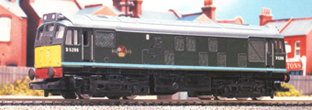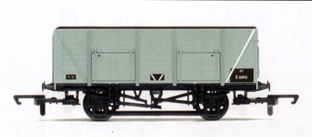Locomotive Class
Class 25 (Type 2)
 Class: Class 25 (Type 2)
Class: Class 25 (Type 2)
Type: Diesel-Electric
Designer: British Railways
Weight: 72 tons
Purpose: Light Passenger & Freight
Information: An elaboration of the earlier Class 24 design also built with Sulzer power plants, the Class 25 saw minor appearance differences with both modest speed and horsepower increases. Numerous Class 25 locomotives primarily saw service on the Midland and Scottish Regions of British Railways. They also saw service on the Western Region as interim replacements for the Class 35 Hymek locomotives upon withdrawal in 1972.
Details: Class 25’s diesel–electrics were of true mixed traffic design being allocated primarily to the Midland and Scottish Regions of British Railways although initial batches were introduced to the Eastern Region. Eventually 327 locomotives were built by various workshops, notably Derby, Crewe, and Darlington.
Once in operation, the Eastern Region quickly shed their allocation of locomotives to the LMR in favour of the larger Brush Type 2 (Class 30/31) design built by Brush. The class was released to traffic commencing in May 1963 with the last member entering traffic in July 1966. Built to Type 2 specifications and later reclassified Class 25 under TOPS, the diesel-electric design never achieved a high profile status in British Railways rosters.
The locomotives were usually roistered on inter-regional passenger workings, parcels traffic, or freight service. Freight workings often necessitated double heading and / or the use of brake tenders due to their light weight. The design proved capable of 90-MPH top speed operation. Problems with the class were relatively few, with sheet metal corrosion being a noted exception.
Liveries varied considerably between locomotives in early years with early examples being turned-out in solid Brunswick green with gray roofs. Later examples received light green stripes on the lower body side and later units received a two tone green livery. All units were subjected to the mandatory small yellow warning panels at both cab ends after 1964. Toward the end of production by late 1966 locomotives entered service in the new Corporate blue livery with full yellow ends, eventually being adopted by class members as they received major service.
During the late 1970’s much of the work the class was originally designed for had disappeared from the contemporary railway scene. The use of mixed traffic engines was no longer required and as such the class was completely withdrawn March 1987, with 20 members surviving into preservation in varying operational condition where their light weight and size has proven invaluable to their operators.
John Faulkner
Class 25 (Type 2) Releases (11)
| MODEL | NO. | LIVERY |
|---|---|---|
| Class 25 (Type 2) Bo-Bo Locomotive | 25247 | B.R. Blue |
| Class 25 (Type 2) Bo-Bo Locomotive | D7596 | B.R. Green |
| Class 25 (Type 2) Bo-Bo Locomotive | 25241 | B.R. Blue |
| Class 25 (Type 2) Bo-Bo Locomotive | D7571 | B.R. Green |
| Class 25 Bo-Bo Diesel Electric Locomotive | D5206 | B.R. Green |
| Class 25 Bo-Bo Locomotive | 25218 | B.R. Blue |
| Class 25 Bo-Bo Locomotive | D5177 | B.R. Green |
| Class 25 Diesel Electric Locomotive | D7596 | B.R. Green |
| Class 25 Diesel Electric Locomotive | D7581 | B.R. Green |
|
Class 25 Diesel Electric Locomotive
Released:
2001
|
25056 | B.R. Blue |
|
Class 25 Diesel Electric Locomotive
Released:
2001
|
25033 | B.R. Blue |
Class 25 (Type 2) Images (11)

Class 25 (Type 2) Bo-Bo Locomotive 25247

Class 25 (Type 2) Bo-Bo Locomotive D7596

Class 25 (Type 2) Bo-Bo Locomotive 25241

Class 25 (Type 2) Bo-Bo Locomotive D7571

Class 25 Bo-Bo Diesel Electric Locomotive D5206

Class 25 Bo-Bo Locomotive 25218

Class 25 Bo-Bo Locomotive D5177

Class 25 Diesel Electric Locomotive D7596

Class 25 Diesel Electric Locomotive D7581

Class 25 Diesel Electric Locomotive 25056

Class 25 Diesel Electric Locomotive 25033

















